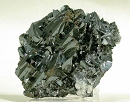
|
| Tetrahedrite |
Chemical
Formula |
(Cu,Fe)12Sb4S13 |
Species |
Sulfides |
Crystal
System |
Isometric |
Mohs
Scale |
3-4 |
Specific
Gravity |
4.97 |
Color |
Steel gray to iron-gray |
Streak |
Black, brown to dark red |
Luster |
Metallic |
Refractive
Index |
n greater than 2.72 |
Diaphaneity |
Opaque |
Cleavage |
None |
Fracture |
Sub-Conchoidal |
| Crystal Habit:Groups of tetrahedral crystals; massive, coarse to fine compact granular |
| Geological Setting:Low to moderate temperature hydrothermal veins and contact metamorphic deposits. |
Tetrahedrite is a copper antimony sulfosalt mineral with formula: (Cu,Fe)
12Sb
4S
13. It is the antimony endmember of the continuous solid solution series with arsenic bearing tennantite. Pure endmembers of the series are seldom if ever seen in nature. Of the two, the antimony rich phase is more common. Other elements also substitute in the structure, most notably iron and zinc along with less common silver, mercury and lead. Bismuth also substitutes for the antimony site and
bismuthian tetrahedrite or
annivite is a recognized variety. The related, silver dominant, mineral species freibergite, although rare, is notable in that it can contain up to 18% silver.
Tetrahedrite gets its name from the distinctive tetrahedron shaped cubic crystals. The mineral usually occurs in massive form, it is a steel grey to black metallic mineral with Mohs hardness of 3.5 to 4 and specific gravity of 4.6 to 5.2.
It occurs in low to moderate temperature hydrothermal veins and in some contact metamorphic deposits. It is a minor ore of copper and associated metals. It was first described in 1845 for occurrences in Freiberg, Saxony, Germany.


 YueGongAnBei 44051102000467
YueGongAnBei 44051102000467


 |
|